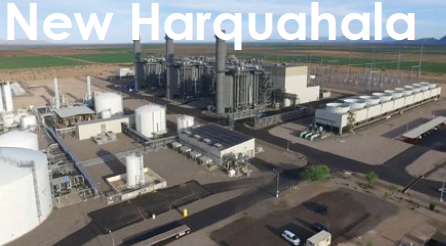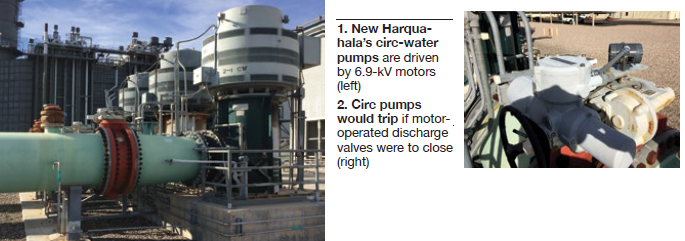Still correcting design deficiencies more than a decade after COD

Challenge. New Harquahala’s three 1 × 1 G-class combined-cycle power blocks are served by two mechanical-draft cooling towers. The middle unit in the plant photo, equipped with two 50%-capacity circulating-water pumps, relies on both towers to satisfy its cooling requirements.
New Harq’s circ-water pumps are driven by 6.9-kV motors which receive power directly from the main power feed associated with their unit. Thus, the pumps shut down when power is lost to the unit served.
However, the supply power to the motor-operated discharge valves (MOVs) for the middle unit is split this way: Cooling tower A’s motor control center (MCC) supplies power to the discharge valves on A tower and cooling tower B’s MCC provides power to the B tower discharge valves. Power to the cooling tower MCCs can be lined up from any of the three generating units.
The logic was designed such that if the MOV were closed, it would trip the circ-water pump to protect it. The pump also would trip if the MOV lost power. This is not an issue for the other two units because they take suction from, and discharge back to, the same cooling tower.
Designers did not consider that if one of the pumps—specifically one on the unit sharing water from both towers—tripped off from loss of power with the MOV open, circulating water would be pumped directly from A tower to B tower, or vice versa. The plant is designed with a cross connect for equalizing the towers; however, circ-water flow at a rate of 60,000 gpm, it is not capable of keeping up. This would certainly cause the receiving cooling-tower basin to overflow.
In 2016 there were two situations where this occurred. One was a fault that occurred on the Unit 3 main feeder breaker which terminated the power to cooling tower B MCC. The second occurrence: A contractor conducting relay tests on Unit 1 accidentally tripped open the switchyard, causing the loss of power to cooling tower A MCC.
Plant personnel conducted a root-cause evaluation (think reliability cause map) to determine what options were available to ensure events, such as stated above, are mitigated. The following options were evaluated:
- Rewire the MOVs back to the main power feed at the unit. This was rejected as very costly.
- Move the supply power for the pumps from the specific unit to the specific cooling tower MCC. Very costly, plus evaluation of the MCC’s capacity was required.
- Add a battery backup for the power supply.
- Install an additional positioner on the discharge MOV that receives loop power from the DCS.

Solution. Find and install the most cost-effective option that increases the reliability of the Unit 2 circ-water system to ensure against a basin overflow event. After careful evaluation, staff determined the most cost-effective option was to procure and install the secondary positioner on the discharge MOVs. Loop power from the DCS was available at the discharge MOVs already and required minimal labor for the install. After the management-of-change process for design and implementation was approved the work was completed by plant employees.
Results. This upgrade has significantly increased the reliability of Unit 2’s circ-water system and will prevent a tower basin from overflowing if power is lost to one of the two circ-water pumps while Unit 2 is operating.
Project participants:
Nathaniel Larson, lead maintenance technician
Will Emeigh, ICE technician
Kyle Hardy, plant engineer ll
New Harquahala Generating Co LLC
Owned by Talen Energy
Operated by NAES Corp
1080-MW, gas-fired, three 1 × 1 combined cycles located in Tonopah, Ariz
Plant manager: Andy Duncan



